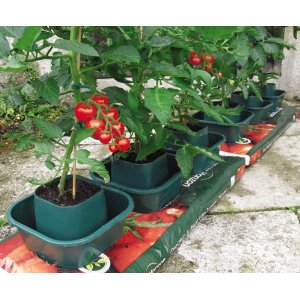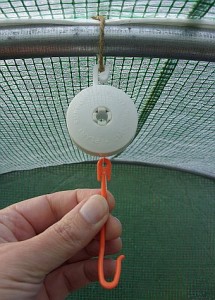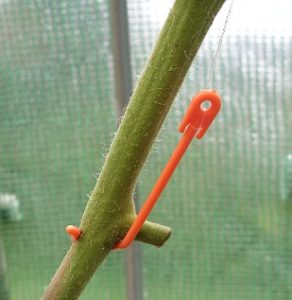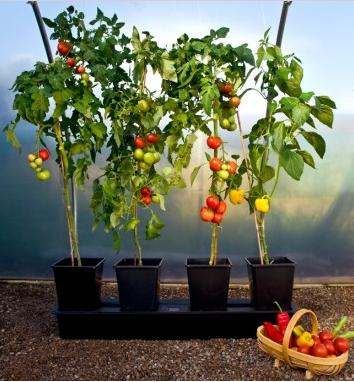As we approach final position planting and our tomato plants can stay outside overnight, I thought it good to discuss some of the equipment and accessories that are regularly used by keen tomato growers. Also, give a tip or two on how to use them for the best results.
Grow Bag Pots – Ring Culture
Grow bag pots (Grow Pots) are one of the best ways to enhance the growing capability of a grow bag.
The idea is that tomato plants receive water plus food poured into the inner ring, and receive plain water poured into the outer ring. This growing method is sometimes called ring culture.
 The fine roots around the plant’s stem in the inner ring absorb the nutrients, and the longer roots and tap root absorb the water that has been poured into the outer ring and into the larger grow bag area.
The fine roots around the plant’s stem in the inner ring absorb the nutrients, and the longer roots and tap root absorb the water that has been poured into the outer ring and into the larger grow bag area.
The benefits of having two separate compartments.
- Targets food to fine roots which gives better growth.
- Prevents nutrients being washed away when plants are watered near stem.
- Food is always available to the plant.
- Helps prevent fungal and root disease by keeping stem area dryer.
- Increases the total growing area of a grow bag.
- Grow bag pots also help prevent slugs and other critters from getting to the tomatoes.
Grow bags are a great way to grow tall tomato varieties and by using these pots, will increase the health, rate of growth, the taste and amount of tomatoes that you’ll receive! More Here.
Air Pots
Air pots are great for allowing oxygen into the root zone and for root pruning which increases vigour.
However, there are a couple of issues with air pots that need sorting!
Watering from Below
Watering from below is my preferred method of watering – usually in trays and fed by a smart valve or aqua valve.
The problem is, the bottom of the air pot is above ground level – there will be a cavity even if you have the base insert at its lowest setting.

The way to overcome this issue is to add one or two strips of capillary matting when the base is inserted. After a while the roots will grow down through the base and into the water in the tray if the tray is kept regularly watered.

Watering from Above
Watering from above has its problems if you don’t fill the pot to the top inch with soil.
Although there are no holes around the very top of the pot, the holes lower down are still too close to the top.
Water gushes out of the side holes near the top and takes compost or other media with it – making a mess in the tray etc.
The fix for this is to insert a strip of plastic around the top of the pot – inside – and block the holes, to a depth of 3 or 4 inches. Cling film is the easiest option.
Drying Out Too Quickly
One issue is … the pot doesn’t need as many holes at it has – they only cause the soil to lose moisture quickly.
Conclusion
For all its faults, the air pot is still an excellent pot in which to grow tomatoes – I use them each season – with a few tweaks of course!
Stood in trays, with capillary matting as wicks, along with a reduction in the side holes – the air pot works very well. However, the fabric type pot is a very good alternative.
Yoyo Plant Supports
 YoYo plant supports are a very useful device for the tomato grower.
YoYo plant supports are a very useful device for the tomato grower.
They are better than canes or string and plants can be tied-up easily, quickly and safely – no broken string and let-downs in the middle of the night!
If you use two per plant, you won’t need to wind the nylon line around the stem – just attach it below a leaf joint.
.
.
.
 Using these supports, plants can be grown vertically or at a 45 degree angle for extra stem length and more trusses – before reaching the greenhouse roof!
Using these supports, plants can be grown vertically or at a 45 degree angle for extra stem length and more trusses – before reaching the greenhouse roof!
Another use is to support individual trusses of heavy fruit. Large varieties can get to the point when the stem of a truss can no longer support the weight of tomatoes.
The only down-side of the Yoyo is that the spring tension can go after a season or two, but it can still be used and adjusted manually. More Info. Here
The Quadgrow Planter
I’ve been using the Quadgrow Planter since they first came on to the market and I am very impressed with it.
Comprising of four pots (or more) that sit on a reservoir of water and nutrients. This has the following benefits when compared to standard pots and grow bags.
Quadgrow System
- Keeps soil constantly moist – from smart reservoir below.
- Avoids over or under watering – plants absorb water as they need it.
- Avoids over or under feeding – nutrients are added to reservoir and nutrients are constantly available to plants.
- Ideal for holiday breaks – the 30 litre reservoir can be extended by a holiday watering kit.
Ordinary Pots and Grow Bags
- Plants need to be watered every day – more in hot weather.
- When soil is dry, a good watering can cause tomato split.
- Soil that is under or over watered can cause nutrient deficiency including Blossom End Rot.
- Soil that is too wet can cause poor root development and eventually fungal disease spreading from the lower leaves.
The Quadgrow eliminates some of the biggest problems when growing fruit and vegetables and has many of the same benefits that professional growers enjoy when growing tomatoes – namely, a regular supply of water and nutrients that are accessed by plants as they require them.
This produces healthier and quicker growing tomato plants and therefore, a harvest of quality tomatoes earlier in the season compared to conventional pots and grow bags.
The system is easy to set up with plenty of guidance on how to mix and apply the nutrients that are included with the quadgrow.
The reservoir, feeder tray and pots are all strongly made and should last for a good number of seasons, returning the cost of the item and the time involved with a successful harvest each season.
With the Quadgrow planter system, you will be able to achieve maximum results for the minimum amount of time spent – I highly recommend it. More about the Quadgrow
watering valves…
The Smart Valve
I’ve been using the smart valve for the last few seasons and have been very pleased with the results.
My experience hasn’t been trouble free however, so it’s good to be aware of one or two issues that may arise, to make sure that the valve will do the job it’s meant to.
The Dry Period
The big question with any wet/dry cycle valve is at what point it opens to re-flood a tray – or in other words, how long is the dry period?
This is very important in hot weather and could leave plants under watered if the valve takes too long to respond.
Of the eight valves I tried last season, most took their time during the dry period and I was concerned that under watering may occur. The plants seemed to be OK though!
Use The Right Media
I found that compared to the Aquavalve, the Smart Valve does have a longer dry period and therefore I would recommend using media that absorbs plenty of moisture such as coir – also known as coco or coconut shell.
Adjustments
It has a level adjustment which is very useful, especially when using in large trays that may not be perfectly level.
It can be clipped to the side of a tray in order to stop it moving around and it is very easy to set up.
Overall, I like the smart valve and the people who make it, Smart Tech Ltd in Glasgow, are very helpful and are updating the product every season to perform to its best.
The AquaValve
The Aquavalve is part of the Autopot Easy2Grow system but also works on its own as a watering valve for trays.

It comes in two parts, the valve and valve lid.
You won’t need the lid when using it with the Autopot system, but when used in trays, the cover can be weighted down to stop the valve floating on the water surface when a tray is flooded.
The valve provides a wet/dry cycle and compared to the Smart Valve, the Aquavalve runs on the wet side – flooding a tray sooner rather than later.
The opposite is true of the smart valve which has a longer dry period.
It’s always good to use a mix that includes plenty of perlite or other well aerated media – especially if a valve runs on the wet side of things. This prevents anaerobic bacteria building-up in waterlogged soil and effecting the roots.
Trays need to be kept level and water pipes can be clipped to the side of trays for keeping the valves in position.
When attaching a pipe, the nipple on the valve could be vulnerable to breaking off, if not handled with care. Dipping the pipe end in hot water to connect the valve (and disconnect) is helpful and makes it easier to push on and remove.
Here’s a video that explains the features of the valve.
When you get to know how it works best, and its peculiarities, it will provide many seasons of excellent results.
The downside of using watering valves is that they have to be fed by a water butt or other large container and tubes and pipes can become clogged.
One great benefit about the Quadgrow is that it relise on capillary action rather than mechanical action.
To Sum Up
It would be easy to spend a small fortune on equipment and accessories, but a well planned investment could provide both excellent results and good value over many summers!
Regards,
Nick
PS What are your thoughts and experiences of the equipment above?


Jess Allaway
Hi Nick, thank you for another informative newsletter. Good tip re the cling film round top of air pots because as you say the space from top of pot to compost level is very short. My problem really with a.p.’s was the reservoir. I fed two “wicks” down the pots into trays of water (the pots raised to keep them above water level) but as the water tray was not enclosed in any way it very quickly formed green algae on top. This might have been caused by my water supply coming from the passing burn, mains water being too far away. Not sure how to use them this year. Just like standard pots maybe. Blocking some of the holes like you suggest should improve the water retention.
Nick
Hi Jess,
If you can make your trays of water light proof (more or less) with an apron of white/black plastic sheeting, you’ll prevent the algae and also stop leaves etc from falling into the trays.
Algae is a big problem when using trays. I also use the white sheeting on the front of my black pots to prevent them from becoming too hot in the sun.
Rob
Hi Nick, thank you for another interesting and informative newsletter.
I usually grow my greenhouse plants in 20 litre pots on saucers – more recently with the addition of air pipes. A couple of years ago I tested the “growpots on growbags” setup but found no noticeable difference in health or productivity of the plants. However, I found the growbags acted as slug magnets. I lost count of the number of slug nests I emptied from the growbags at the end of the season. I wondered where they were coming from!
For reliable watering during holiday times, I am fortunate to have the best possible solution: a wonderful neighbour who shares my passion for growing tomatoes.
One question please, Nick: When planting seedlings to the depth of the first “true” leaves, do you recommend removal of the seedling leaves (cotyledon) or leaving them intact? Thank you.
Nick
Hi Rob,
I usually remove the seed leaves – by the time I transplant they are looking pale and light green as the nutrients are sent to the growing tip, so they serve no use to the plant.
Mark Fairhurst
Thank you Nick. I’ll give it a test. I am pretty sure that the ph is very high. I have the kit to do it, from my greenhouse sensations hydroponic kit. I remember some years ago discussing this with GS but they said adjustment was uneccesary because the roots are in compost but this did not sit right with me because I know many roots end up growing into the resevoir!
Mark Fairhurst
I love my quadgrows but I have a slight concern. I can see lots of roots already in the water resevoir. I have very hard water and although I use hard water nutrients later in the season, should I acidify the water in the tank as I would with a hydroponic system?
Great site and great info Nick.
Nick
Hi Mark, It’s normal for the roots to grow down into the reservoir.
You may like to test the pH of the water by siphoning a little out and testing it.
The pH is usually reduced when the feed is added but if you are in a high pH area, you’ll get better results by reducing the reservoir pH if it is still high.